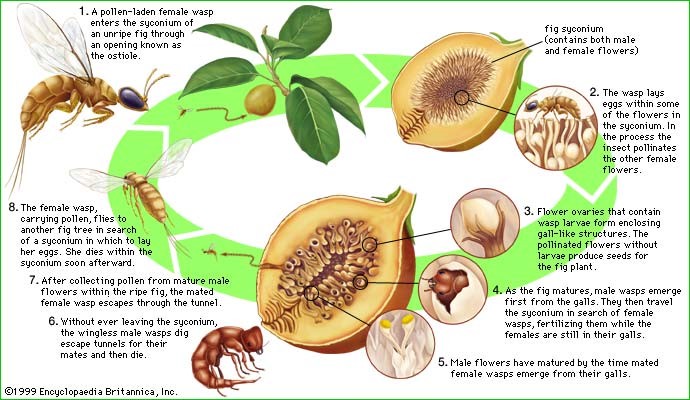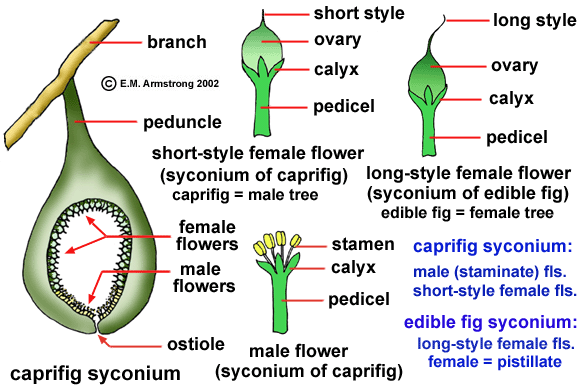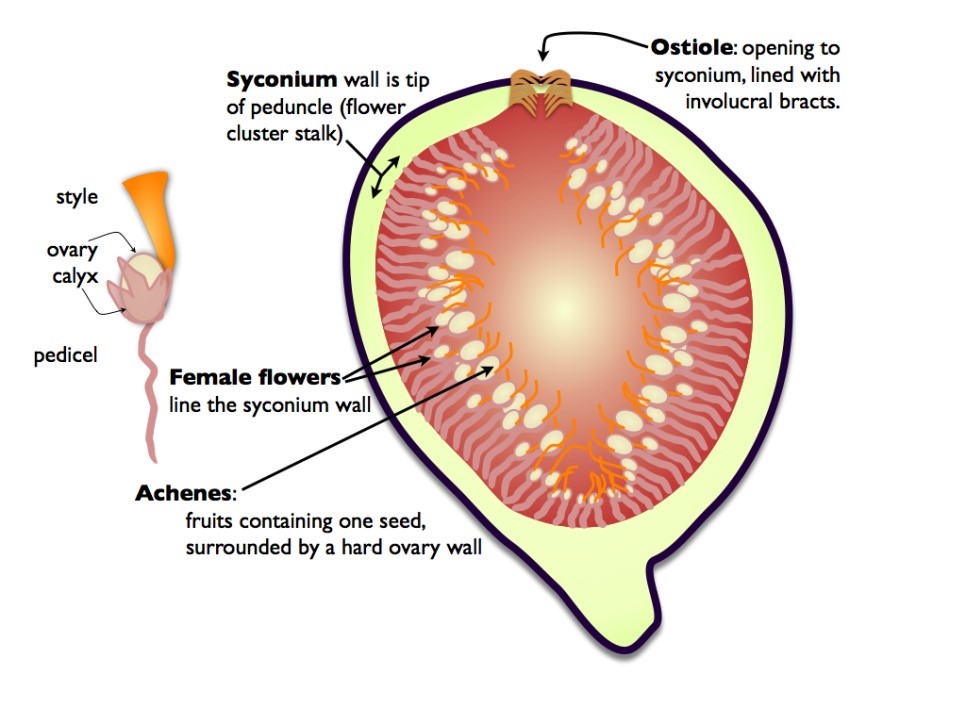Fig (Ficus carica L.) is a fruit of warm temperate zone. It is one of the oldest fruits known to man and has been eulogized by well known Greek writers homer and plato. Mention about this fruit has been made in the earliest chapters of Bible. Fig trees are generally thriving in the field of mild Mediterranean climates. They serve as an excellent indoor pot plant in cooler zone. The fruits are developed from the inverted flowers of the tree. The seeds are inner side of the fruit which are sweet and delicious in the taste. There are over 200 different varieties of fig varies in height from 10 and 30 feet. Fig trees have a potential to become invasive in some locations.
Figs are plants in the genus Ficus, which have a unique closed inflorescence called a syconium typically containing hundreds of flowers. We eat the ripe syconia of one species, F. carica and call these ‘pseudo fruits’ figs too. There are about 750 fig species worldwide, mostly in the tropics, where dramatic ‘strangler’ figs are found. These start life as epiphytes on other trees and then drop aerial roots that slowly smother and kill their host. Figs have an obligate mutualism with tiny fig-pollinating wasps (family Agaonidae). Female wasps enter receptive syconia, where they pollinate female flowers. They also lay eggs into some flowers, where their larvae induce galls. Some weeks later, the wasp offspring emerge from their galls into the syconium, just as the male flowers have matured their pollen sacs. The new generation of female wasps leave the scyonium through holes made by the males and carry pollen to receptive syconia elsewhere. This symbiosis is exploited by many species of fig-parasitic wasps. Most of them do not enter the syconium or contribute to pollination, but use long ovipositors to inject eggs through the fig wall so that their larvae can feed on either fig flowers or other wasps.
There are four different types of figs namely, Caprifig type, Smyrna type, San Pedro type and Common type. Detail should be given below.
- Caprifig type – Out of that all type of fig this type is considered in first group. Caprifig that means wild or uncultivated fig used to pollinate the domestic edible fig because it can produce tiny non edible fruit. These figs bear only male flowers and never develop into fruit so its main purpose is to pollinate female fig trees only. Caprifig flowers produce pollen and their pollen is transported to the flowers of other fig trees by the fig Blastophaga wasp, a distinct species that lives and breeds inside caprifig flowers. By this wasp fertilization of the Smyrna-type figs and San Pedro-type figs is done. Without the pollen produced by the caprifig and the help of the Blastophaga wasp, non-self-pollinating fig crops would not develop. Fruits of caprifigs in general are not edible due to poor quality. Varieties of caprifig are (a) Croisic and (b) Roeding No.1. Among these, cv. Croisic has completely parthenocarpic edible fruits whereas Roeding No. 1 bears partly parthenocarpic fruits and produce blank fig freely.
- Smyrna type – Smyrna type is another group of figs that produce one crop. These figs bear all female flowers. So that requires pollination for development of good quality fruit. Without pollination, the fruits of Smyrna fig will drop from the trees before they are fully mature. Smyrna fig should be pollinated by a caprifig. These figs cultivars produce second crops that require pollination often fail. So avoiding this type of problem growers place baskets of caprifigs along with the fig wasps that the small caprifigs are hosting near their Smyrna fig trees to ensure that pollination will take place. Varieties under Smyrna type are (a) Bardajik (b) Kassaba (c) Stanford and (d) Lob Injir. Among these Lob Injir develops parthenocarpic fruits.
- San Pedro type – San Pedro figs are third group of fig that produce two crops a year. A first crop (spring crop) is borne on previous season shoots known as breba which is develop without cross pollination. The second crop is borne on the current season’s growth comes later in the season and is the main crop. For proper development of fruits this crop requires pollination by a male flower. Without a pollinator, the crop fails and developing fruits drop to the ground before reaching maturity. The most popular varieties include “Celeste” which rarely produces a breba crop and “Brown Turkey” which produces a small breba crop and a larger main crop. Important San Pedro varieties are: (a) Blanquette (b) Gentile (c) King
- Common type – Common figs are the fourth type usually grown in homeowner. They do not require pollination to mature their fruits and are parthenocarpic. In warmer climate, common figs will often produce two crops in each season and at least one of those crops will develop fruit even if the tree isn’t pollinated. In some situation these fig will drop their first crop but the second crop develops parthenocarpically without fertilization. In other varieties both crops successfully develop parthenocarpically. Because of their less exacting pollination demands, common figs are the most widely available type of fruit-producing fig trees in the United States. Common figs don’t need an opening, so they are less susceptible to rot caused by insects and rainwater entering the fruit. Important varieties are: Beall, Blanche, Bourjassotte, Grise, Kadota (Dottato).
To know more about the practices of fig farming, visit various industrial exhibitions on agriculture technology which provide a platform for bringing together many foreign as well as national visitors to interact with the leading international agriculture technology companies, who exhibit their latest technologies and know-hows for the industry.
Author Article:
Prof. Bhoomika Patel, Prof. Sheetal Jadhav, Dr. V. K. Parmar, Prof. N. M. Patel and A. H. Patel
Department of horticulture, N. M. College of Agriculture,
N.A. U., Navsari- 396450, Gujarat








